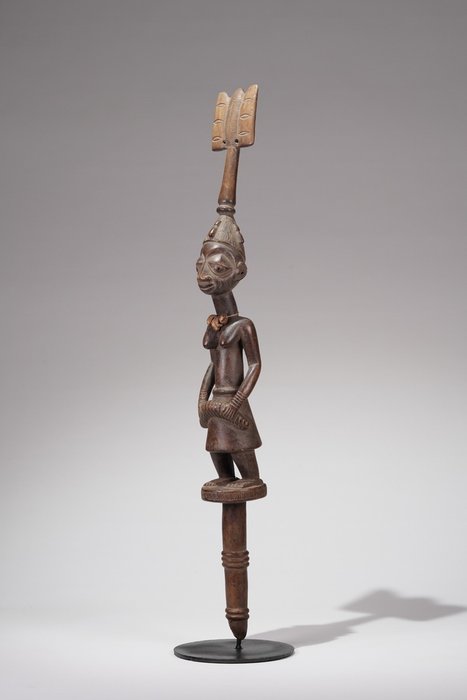
Shango - Yoruba - Nigeria (Ohne Mindestpreis)
Nr. 82853375

Nr. 82853375

A Yoruba Shango staff, from Nigeria of a woman standing on a staff that ends in a circular base; wearing a skirt and hands holding an item that is resting on the legs; her torso exposed with small round breasts, rounded shoulders; her long neck ornamented with a necklace made of a string and cowrie shells as pendant; her face with a dreamy expression with a large mouth, wide nose and large downturned eyes; her head capped by a conical head-dress that supports a the double axed coiffure as is typical in Shango staffs. Both arms have a row of Bracelets, and the bottom of the staff is ornamented with ringed carvings. Signs of Use. Certificate of origin and Provenance.
“In Yoruba culture, hairstyles are often used to signify a person's social status, age, and gender. Different hairstyles can also be associated with different deities or spiritual beings. In the case of Shango, his hairstyles are meant to emphasize his connection to the spiritual realm and his authority as a powerful deity. Additionally, Yoruba woodcarvings often include intricate details and symbolism, and the hairstyles on Shango carvings may be a way to add texture and depth to the art. They may also be used as a way to make the deity appear more lifelike and dynamic.
Overall, the inclusion of elaborate hairstyles on Yoruba Shango woodcarvings is likely a combination of cultural tradition, spiritual symbolism, and artistic expression."
Lit: Booklyn museum; Dallas -museum of Art.
"The oshe Shagon baton is carried in rite and procession by the god of Thunder ́s devotees."
Lit: Robert Plant Armstrong, “Oshe Shango and the Dynamic of Doubling,” African Arts, vol. 16, no. 2 (1983), pp. 28-32.
"The Yoruba people are known for their remarkable skills in art and craft. The majority of their artifacts date back to the late 19th and mid-20th centuries, and are often attributed to a particular carver by name, which is an uncommon practice in African art.
Yoruba artists employ a diverse range of materials including leather, terracotta, bronze, ivory, wood, and glass, among others. Several lifelike bronze sculptures believed to have originated in the 12th century have been discovered."
Lit: Brooklyn museum
„Among the objects used to honor Shango is the oshe Shango, or dance wand. It is carried by Shango priests and devotees during public worship activities and enshrined on the deity's altar. ... The priestesses or female supplicants often depicted on oshe Shango represent Shango's benevolence as he bestows the blessing of children upon his faithful worshippers and protects children, especially twins (ibeji).“ Read more: Shango dance wand ("Oshe" Shango").
Lit.: Dierk Lange: Der Ursprung des westafrikanischen Wettergottes Schango. In: Saeculum, 45, 1994, S. 213–238. Norma H. Wolff, D. Michael Warren, The Agbeni Shango Shrine in Ibadan: A Century of Continuity, African Arts, Vol. 31, (Summer, 1998). Richer Xavier, Joubert Helene, Dance with Shango, God of thunder, 2018.
So kaufen Sie auf Catawiki
1. Etwas Besonderes entdecken
2. Höchstgebot abgeben
3. Sichere Zahlung durchführen